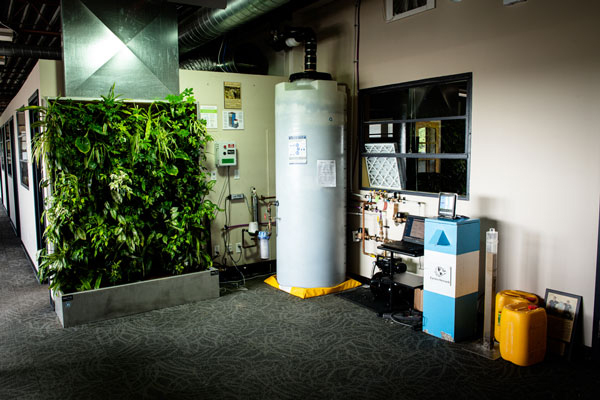Roofs are on the front lines of climate change adaption and the construction industry needs to look forward to accommodate what’s to come, say consultants.
Building codes once assumed roof conditions were static and by nature were prescriptive in how to construct a roof, said Ted Sheridan, president of Fishburn Sheridan Group.
“No one was thinking about climate change,” he said.
Performance standard CSA A123.26 (Climate Resilience of Low Slope Membrane Roofing Systems) looks forward.
“It is a standard that describes building in resilience to climate change. It is not in the building code yet, but it has been around for a couple of years,” said Sheridan.
It sets out the need to design ahead for traumatic events such as winds, fire, hail and temperatures, which impacts everything from insulation R-values to fireproof building materials.
Roofs can also be used to mitigate the impact of climate change, such as blue roofs which capture water, he said.
“Blue roofs are very controversial because we are trained to get water off the roof,” he said.
Bruce Taylor, president and founder of Enviro-Stewards, has incorporated a blue roof onto his building using his own Affordable Smart Blue Roof (ASBR) system.
Using rooftop mediums to capture water and slowly release it can add weight and costly building support.

Taylor uses a liquid liner to reduce weight and it’s applicable to any structure that has a snow loading rating.
“It is 10 times cheaper,” he said.
Taylor removed his old tar and gravel roof, upped the insulation value and added a leak detection system, before putting the roof back on and using a liquid, seamless membrane.
The 5,000-square-foot roof captures water and when it reaches a depth of two inches, controllable drains direct it to storage tanks for flushing toilets or watering a green wall. Water can also remain on the rooftop to evaporate and add to summer cooling or can be slowly released into the municipal storm sewers at a time when it won’t contribute to flooding.
ASBR roofs have the potential to cut air-conditioning, heating and water costs by approximately 50 per cent, estimates Taylor, who recently consulted and designed the newly-completed blue roof on the Credit Valley Conservation Mississauga administration building.
It is now Canada’s first CSA installation following the CSA rain water harvesting system standard.
Blue roofs can also be combined with green roofs using roof water for irrigation or held in substrates. Green roofs, growing at approximately 10 per cent per year in terms of dollar value, have seen the main growth areas as Quebec, Ontario and B.C. with larger urban areas the main adopters, said Steven Peck, green roof consultant and president of North American industry association Green Roofs for Healthy Cities.
In terms of climate mitigation, the green roofs can absorb CO2, provide shading for occupants, while plants releasing water (transpiration) cools the air. Green roofs are being paired with solar panels, said Peck.
“It is a new trend, not so much here, but it is happening all over Europe,” he said, as the cooling ability of green roofs can increase panel efficiency by five to 15 per cent compared to placing them on a hot roof.
However, said Peck, the real potential lies in providing green roofs over larger areas of an urban city to reduce overall heat build-up. Over a large area, green roofs have the potential to bring down air temperature by one to three degrees, he said, and every degree of reduction translates to a four per cent energy savings within the buildings.
“You are taking the edge off the heat wave,” he said.
Not everyone is a fan of green and blue roofs.
Rod Scott, associate director of the Saskatchewan Roofing Contractors Association, said current drought conditions don’t suit green or blue roof technology adaption. The trend his members see is lighter coloured materials to reflect the heat and more insulation during colder months.
In northern Saskatchewan areas in institutional buildings such as schools, he said, there is a move toward sloped metal roofs that will help against large fire threats.
The City of Calgary has encouraged green roof construction during local area planning projects and development applications as well as climate change toolkits, sustainable building policy and a guide to developing green roofs, said communications supervisor Lindsay McDonald in an email, but there has not been wide-spread uptake.
A more common response to climate change is the use of solar panels.
McDonald said the city is exploring blue roof technology.
“We are keeping an eye on pilot projects in other Canadian municipalities,” she said, adding the city “would be interested in connecting with any other potential contacts on blue roofs.”
Researcher Dr. Connell Miller of the Northern Tornado Project (NTP) said studies indicate tornado occurrences are moving more easterly towards highly-populated corridors from Windsor into Quebec. The NTP is advocating for strengthening roof connections to the housing mainframes.
The national building code only requires three-inch toe nails but some municipal codes are now asking for stronger anchoring, Miller said.
Engineers examining tornado debris found many homes were not even constructed to the current standards.
“They have not been built to code,” he said. “And, that is quite concerning.”



The article nicely summarizes that all man made structures (and it’s roofs) have a high environmental footprint that cause multiple negative issues, from heat island effect to combined sewer overflow. Unfortunately hardly non of these issues can be solved with a bright roofing membrane, hoping all these issues are reflected – somewhere. Since every building took away a piece of nature, the logical solution is to put such nature back onto of the building. This is common practice and the most effective and efficient solution in Europe for over 45 years. However, this requires the guts for serious and honest change paired with basic common sense. Where this is available in North America has to answer someone else.